Welcome to FISH FOOD TIMES
Jul. 2015 issue No.139-2
abalone
Sashimi Assorted using tokobushi abalone is as shown on the previous page, and the other hand if you use a small abalone 34g to sashimi Assorted,
�@�@Abalone sashimi Assorted 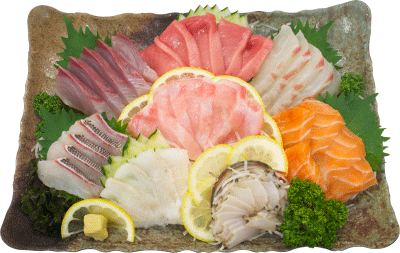
Abalone into sashimi Assorted is got to of this image, I think it is either just saw this in tokobushi abalone, Which is not know at all whether the abalone.
Moreover, since it is small as long as it is a disk abalone there is to eat and firm texture also, it can be seen immediately that's abalone in the teeth touch, but from the fact this is siebold's abalone called red is not hard texture as disk abalone, this it is doubtful either convinced that it abalone by eating.
When it comes to, I think it is needed to use for sashimi Assorted by force the abalone that average monthly wholesale prices will be 7,598 yen/1kg in the Tsukiji market. It seems that it is enough even tokobushi abalone average monthly wholesale price 3,285 yen/1kg.
And to not want to misunderstanding, it is not than the tokobushi abalone are saying good to use named abalone.
Rather than have recommended such a fraud, and if required even hard feel of food while being chewed like a stone of disk abalone, I think than there is no problem even siebold's abalone and giant abalone even tokobushi abalone.
By the way, ezo abalone seemed meat has a hard characteristics to more disk abalone, ezo abalone of very rare existence is like sometimes more than 10,000 yen/kg, even in calm price, that price exceeds the disk abalone though thing of the ordinary, is not it unfortunately author eating ...
Fellow of abalone, including tokobushi abalone has inhabit about approximately 100 types around the world, and over the catch of abalones from 1960 in Japan the 1970s was about 5,000 to 6,000�d. However, in recent years began conspicuous production cuts, since the 1990s is now below the 2,000�d, according to Fisheries and aquaculture production statistics for the most recent 2013 fiscal year, abalones production volume of the whole country has become a total 1,395�d, it is almost a quarter of the production volume from the viewpoint of the heyday.
According to the Shizuoka Prefectural Fisheries Research Institute materials,
| In transition of the country of catch of abalones of the past 50 years (1961-2010 years), in recent years most of Australia, in the early 1970s and 1980s from the late 1960s, and the catch of 7,000 ~ 8,000tIt had been recorded. Then it was reduced, but the past 20 years has maintained a more than 5,000t. Is the Japan of the second most common. In the late 1960s and then decreased it had caught more than 6,000t, in recent years it becomes about 2,000t, from 2010 has become a 1,500t or less. The large third is in the order of about 1,000t in New Zealand. Mexico was a 7,000 ~ 8,000t in the 1960s, in recent years Mexico has been greatly reduced to 1,000t below. The main types of interest of the catch is, in Australia Blacklip abalone; scientific name Haliotis rubra and Greenlip abalone; scientific name Haliotis laevigata, Japan, Ezo abalone and disk abalone, siebold's abalone, etc. tokobushi abalone, in New Zealand Blackfoot Paua; scientific name Haliotis iris) and the like scientific name Haliotis australis; and Yellowfoot Paua. �@�@�@(Excerpts from the Shizuoka Prefectural Fisheries Research Institute documents) |
To make up for catches that have reduced this way, is farmed in the current number of countries have come to be carried out actively. Ezo abalone in Hawaii, Taiwan tokobushi abalone, also South Africa, Australia, such as in if it has farmed abalones also Chile, especially in Chile by diverting the technology of sea farming experience and salmon Rocco shellfish exports, such as the Ezo abalone farmed it seems are imported to Japan.
In addition, China and South Korea both countries is a very actively abalones aquaculture production, South Korea in the 2010 data 6,228�d, China is several orders of magnitude of 56,511�d (of China published data credibility authenticity decision to leave it to the reader ). The main types of Ezo abalone both countries that have been farmed, are imported to Japan is about 1,000 tons per year from South Korea, and has been imported from China it is about several 100 tons, according to our national character to be prized abalone I think however, seems to have been mainly consumed in many of China.
In Japan, we have established mass production technology abalone seedlings, so that the seed discharge is performed actively. In terms of type, Ezo abalone is most often about 60%, and disk abalone is at approximately 30%, tokobushi abalone is not only about the entire 3%. Again I think that the high motivation of the discharge business to have high market price.
Well, from tokobushi abalone is this month's issue of the theme, it was imperceptibly shifted talk to that of abalones in general. But basically tokobushi abalone is, because it is the same and abalone at a point other than that you can use cheap as sashimi material, and trying to be introduced and considered the cooking process that uses a abalone below it's tokobushi abalone.
The following image is a dismantling and sashimi commercialization of the process using a particularly expensive disk abalone among the abalone.
| Disk abalone dismantling and sashimi process | ||
|---|---|---|
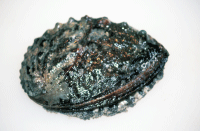 |
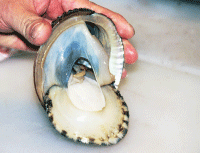 |
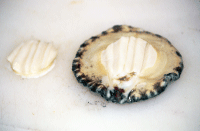 |
| �P�CI prepare what 200g of disk abalone | �W�CWhen the Chop, internal organs and hakama to remain attached to the shell | 15�AState that I disconnected the adductor muscle |
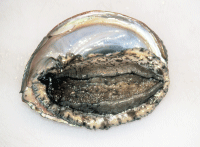 |
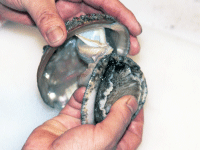 |
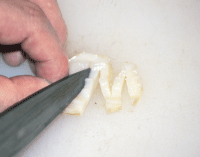 |
| �Q�CAbalone sashimi base, it is important that the living shellfish move about. | �X�CWhen removing the body is to be aware that leaving the internal organs and hakama in shell | 16�APut a staggered cut in adductor muscle with a kitchen knife |
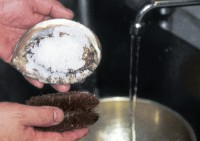 |
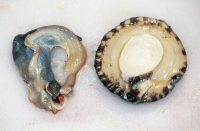 |
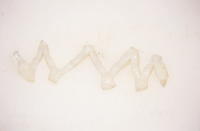 |
| �R�CPlenty put the salt on top of the leg muscles | 10�CWhen the hakama remains in adductor muscle, that it is often damage the adductor muscle when you remove | 17�AOpen the accordion-like |
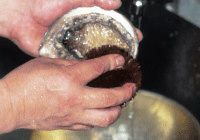 |
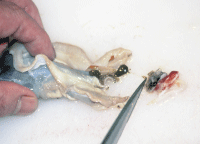 |
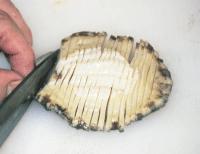 |
| �S�CTake the slime the surface of the muscles by the salt wash | 11�CDisconnect the gills of the internal organs (gills is often remain in muscle) | 18�AIncluding all be hard sites of around, and cut by pulling it with a knife at regular intervals |
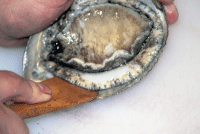 |
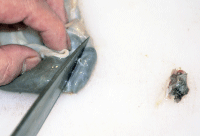 |
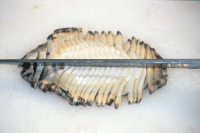 |
| �T�CPut the shellfish special instrument from the longer the shape of the shell of the cross-section has an L-shaped | 12�AWhen you take into commodity Internal organs as edible part, to separate the sand sack | 19�ATo falling one after another muscle in the kitchen knife that you disconnected by pulling |
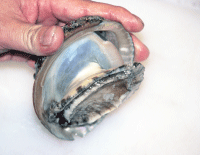 |
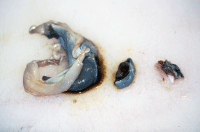 |
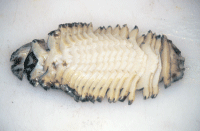 |
| �U�CInternal organs portion is located at the top, tilting the body away from the shell | 13�CLiver (gonads), sand sack, gills, internal organs portion which is separated | 20�AIt expand to transverse the whole at regular intervals |
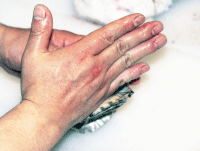 |
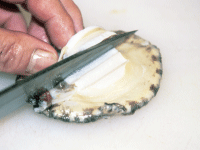 |
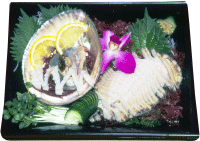 |
| �V�CLightly Chop on the tilted muscle | 14,Cut off the adductor muscle in the wavelet-cutting | 21�Adisk abalone sashimi (gonad called liver green female, white male) |
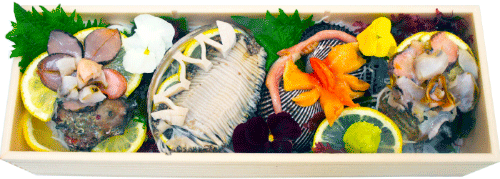 |
||
| Including abalone, sashimi alive shellfish Assorted | ||
Thus alive in that it has been made a sashimi products using the abalone, of course because the cost long as 200g of abalone is one of 1,000 yen or more at a minimum must be prepared, it becomes what the selling price is naturally high the coming of the nor try to avoid.
Abalone whole one using, it just becomes like "image 21" above when you try to commercialized in, there is no volume in spite of the selling price, it becomes to those little low cost performance.
If I will increase the more cost-performance using the abalone, such as "sashimi Assorted of abalone containing alive shellfish" in the image above, for example, along with such as turban shells and ark shell, and cheaper price than abalone material in combination, if so feel little volume, it is possible somewhat to dilute the expensive feel.
Nevertheless than abalone that contains one whole it is it is inevitable that it becomes inevitably higher selling price. So when you devised such as the following, fairly and thus to reduce the commodity cost.
�@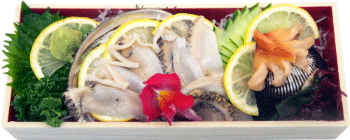 �@
�@ 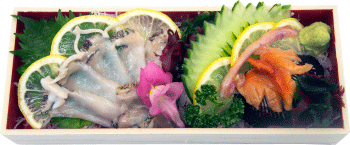
The point of this product, how to abalone to sashimi in the hikitukuri sashimi instead usutukuri sashimi, abalone is cost, since put in only 1/2 he halved.
In this way, he commodity selling price also comes out a possibility to achieve the level that does not exceed 1,000 yen.
However, since the shells of abalone is only one, it is no shell in one of the commodity. It is not the way to become the feel to the pales a little that there is no one product shell.
Even so, as abalone monthly average wholesale price of May of 2015 of the Tsukiji market shown by the figure of 7,598 yen/1kg, because although trading market is the luxury goods of very high price, still abalone was big price break is I've never heard so much.
This is always also have to maintain the high stability of the plateau rate, not only in Japan because abalone is, probably because there is a big advantage to continue there is a constant high demand from abroad.
Abalone is a typical food that has been treated from the old days of ancient not only now as a "valuable luxury goods which leads to longevity." The word "noshi" of the "Noshi sack" to use such gifts is, in the process of creating a "stretch (noshi) abalone", thing that has come from the fact that stretch thin.
Once upon a time in Japan, and to deliver to remote earth as gifts of the abalone to the court, it is necessary to the abalone to dried fish, in order to dry the thick of meat abalone completely, so as to face the apple skin, and long by the method of drying by cutting it is possible to the had to "stretch abalone".
At the beginning, it of course had been used as a food, but becomes strong meaning case of gifts after it, was changed as this is served in celebration of the gift-giving. And it gradually, such as current, it seems paper into formal ones made of such as were being simplified.
In Japan, there is a history of such abalone, on the one hand, China from Japan "Dried abalone" has since been exported to China, as "food which leads to longevity" from the Ming through the Qing Dynasty era, and of the high status of such courtIt began to widely penetrate between people. However itself caught abalone fish in China's domestic is very low, there was a need to rely on imports for the majority from Japan.
The dried abalone, it is made using a large siebold's abalone and giant abalone, there is a gloss like candy red-brown, but that it is hard to be a feature.
How to make of dried abalone, in first remove the meat from the shell, and to it rubbed salt, washed dipped from it in 4-5 days water, drying and from then boiled abalone until there is about 40-50 days moisture in the sun of it is that, it's a luxury and costly which has passed through the long days and a large number of personnel on of the process goods with.
In this way, the abalone is also not sold in a state in which if alive, it is if the dried abalone, as well as a long period of time can be saved, there is the advantage of being able to export anywhere in the world as a high-quality materials of Chinese cuisine. So even without unreasonable cheap, because there is an absolute strength of a way to sell some plenty, it will be the able to maintain a consistently high price of abalone stable.
Ahead China is also such that no imported abalone products exactly the one of abalone, such as dried abalone of Japan, as long as it is not also a major environmental change in the international needs, remain a abalone "flower out of reach," always in the futureIt is should, no doubt that it will continue to reign as a super-luxury of fish and shellfish.
Such abalone and was very similar, if a living tokobushi abalone is than available at the price of around 100 yen in one, or would not than not to be missed this.
Let toward the little eyes to tokobushi abalone minor presence.
To previous page
An opinion and the communication are to iinfo@fish food times
Date of updating Jul.1, 2015
